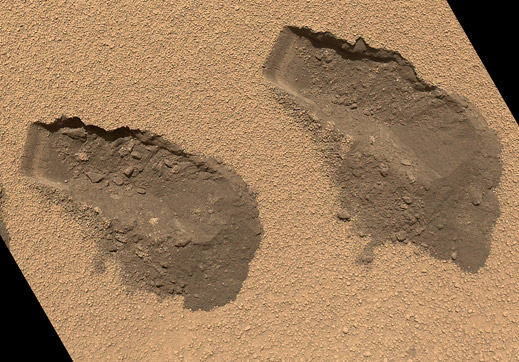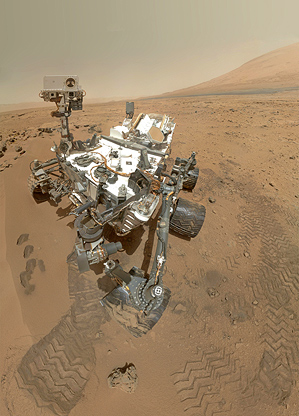Mars Rover Finds Puzzling Organic Traces in First Soil Sample
NASA announced yesterday that the Curiosity Mars rover has found small amounts of simple organic compounds—the building blocks of life—in three samples of Martian soil, but cautioned it is too soon to say whether the carbon in that material came from the Red Planet or hitchhiked there from Earth. Experiments on both the rover and in labs around the world will attempt to find the answer over the coming weeks.

Organic material is not evidence for life—it is found on comets, for example—but it does make up the building blocks of life, and has never been found on Mars, leading to a frenzy of excitement over its possible discovery by Curiosity.
SAM—or the Sample Analysis at Mars—is the instrument capable of finding organic, or carbon-containing, material in Martian soil or rock samples. Rover scientists discussing SAM’s finds at the American Geophysical Union meeting in San Francisco yesterday said they had no definitive evidence for organics on Mars. Simple organic compounds called chloromethanes were produced in small amounts when SAM heated soil taken from a sandy area called “Rocknest.”
If the carbon is from Mars, it might have come from minerals—such as magnesium carbonate—or organic compounds that fell to the planet on meteorites or, just maybe, formed there by life.
The problem, says SAM scientist Michel Cabane of the Pierre and Marie Curie University in Paris, is that the carbon might have come from Earth, perhaps left over from when organic material was used to put the instrument through its paces before launch.
So how will the team test for terrestrial contamination?
SAM’s chief scientist, Paul Mahaffy of NASA’s Goddard Space Flight Center in Greenbelt, Maryland, says one way is to drill into one of five pieces of specially doped glass carried onboard Curiosity and run that material through the sample analysis system. “If we see the same stuff” that was thought to come from Mars, Mahaffy said at the briefing, “we gotta say, ‘hold the show—this might be terrestrial stuff.’ “
And even if the carbon did come from Mars, it might not have formed there. Dozens, if not hundreds, of metric tons of organic material are thought to fall on the Red Planet every year in the form of meteorites. Studying the ratio of different isotopes of carbon—something SAM can do—could help distinguish between a meteorite and a terrestrial source of carbon, says Cabane.

Isotopes might also provide some clues about whether or not any carbon came from life itself. On Earth, life uses more carbon-12 than carbon-13, so seeing a similar signature on Mars could hint at a biological source.
The rover’s other instruments will also provide helpful context for figuring out whether Martian carbon formed on the planet itself—by geochemical processes or life—or fell from space via meteorites. That’s because measuring the exact mineral makeup of a sample of rock, something an instrument called CheMin can do, shows the conditions under which it formed. “As you can see, it’s a complicated decision pathway there, and we have to explore each one systematically,” John Grotzinger of Caltech, the mission’s principal scientist, said at the briefing.
“We have a lot of work to do,” agrees Cabane, adding that the SAM team plans to run different mixtures of chemicals through SAM-like instruments at Goddard and in Paris, to see which combinations best match SAM’s actual results.
SAM will also continue taking samples on Mars. The instrument has only analyzed samples from sandy soil—taking its first soil sample on November 9. The samples came from just below the surface, a place where solar radiation and particles from space, along with reactive gases in the atmosphere such as hydrogen peroxide, should destroy organic molecules. “It’s not unexpected necessarily that this sandpile would not be rich in organics,” Mahaffy said at the briefing. “It’s been exposed to the harsh Martian environment.”
Rover scientists will spend the next few weeks scouting for a rock to drill into. If they are present, “organic molecules in the rock should be more pristine” than in porous soil, says Cabane, since they should be more shielded from radiation and cosmic rays.
Keep Reading
Most Popular
Large language models can do jaw-dropping things. But nobody knows exactly why.
And that's a problem. Figuring it out is one of the biggest scientific puzzles of our time and a crucial step towards controlling more powerful future models.
The problem with plug-in hybrids? Their drivers.
Plug-in hybrids are often sold as a transition to EVs, but new data from Europe shows we’re still underestimating the emissions they produce.
How scientists traced a mysterious covid case back to six toilets
When wastewater surveillance turns into a hunt for a single infected individual, the ethics get tricky.
Google DeepMind’s new generative model makes Super Mario–like games from scratch
Genie learns how to control games by watching hours and hours of video. It could help train next-gen robots too.
Stay connected
Get the latest updates from
MIT Technology Review
Discover special offers, top stories, upcoming events, and more.